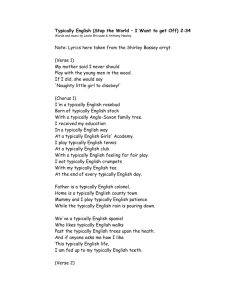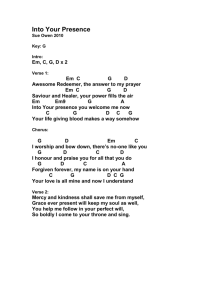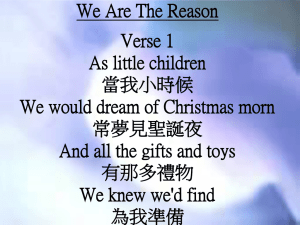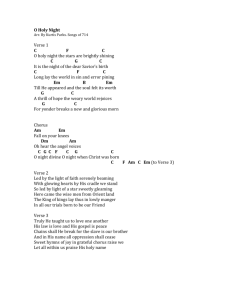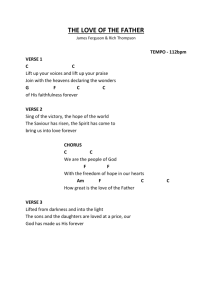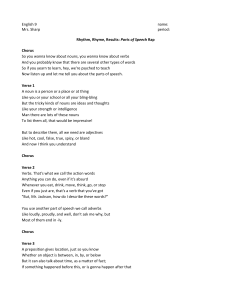16 measures Chorus (Hook) - Dr. Kirk Kassner's Web Site
advertisement
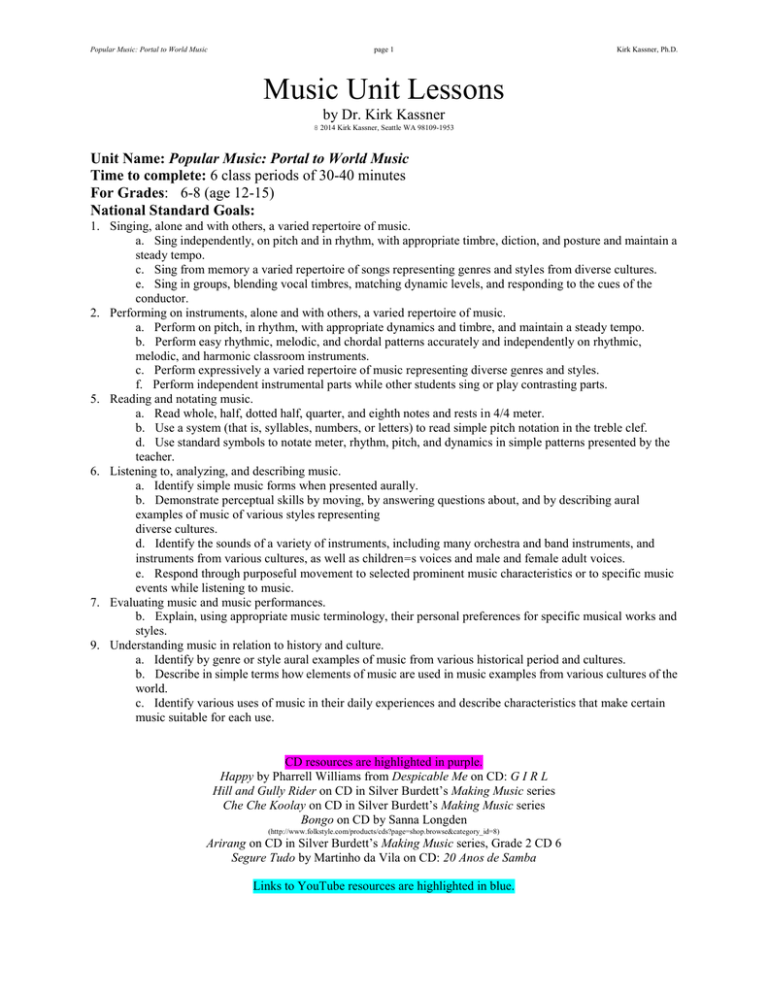
Popular Music: Portal to World Music page 1 Kirk Kassner, Ph.D. Music Unit Lessons by Dr. Kirk Kassner 8 2014 Kirk Kassner, Seattle WA 98109-1953 Unit Name: Popular Music: Portal to World Music Time to complete: 6 class periods of 30-40 minutes For Grades: 6-8 (age 12-15) National Standard Goals: 1. Singing, alone and with others, a varied repertoire of music. a. Sing independently, on pitch and in rhythm, with appropriate timbre, diction, and posture and maintain a steady tempo. c. Sing from memory a varied repertoire of songs representing genres and styles from diverse cultures. e. Sing in groups, blending vocal timbres, matching dynamic levels, and responding to the cues of the conductor. 2. Performing on instruments, alone and with others, a varied repertoire of music. a. Perform on pitch, in rhythm, with appropriate dynamics and timbre, and maintain a steady tempo. b. Perform easy rhythmic, melodic, and chordal patterns accurately and independently on rhythmic, melodic, and harmonic classroom instruments. c. Perform expressively a varied repertoire of music representing diverse genres and styles. f. Perform independent instrumental parts while other students sing or play contrasting parts. 5. Reading and notating music. a. Read whole, half, dotted half, quarter, and eighth notes and rests in 4/4 meter. b. Use a system (that is, syllables, numbers, or letters) to read simple pitch notation in the treble clef. d. Use standard symbols to notate meter, rhythm, pitch, and dynamics in simple patterns presented by the teacher. 6. Listening to, analyzing, and describing music. a. Identify simple music forms when presented aurally. b. Demonstrate perceptual skills by moving, by answering questions about, and by describing aural examples of music of various styles representing diverse cultures. d. Identify the sounds of a variety of instruments, including many orchestra and band instruments, and instruments from various cultures, as well as children=s voices and male and female adult voices. e. Respond through purposeful movement to selected prominent music characteristics or to specific music events while listening to music. 7. Evaluating music and music performances. b. Explain, using appropriate music terminology, their personal preferences for specific musical works and styles. 9. Understanding music in relation to history and culture. a. Identify by genre or style aural examples of music from various historical period and cultures. b. Describe in simple terms how elements of music are used in music examples from various cultures of the world. c. Identify various uses of music in their daily experiences and describe characteristics that make certain music suitable for each use. CD resources are highlighted in purple. Happy by Pharrell Williams from Despicable Me on CD: G I R L Hill and Gully Rider on CD in Silver Burdett’s Making Music series Che Che Koolay on CD in Silver Burdett’s Making Music series Bongo on CD by Sanna Longden (http://www.folkstyle.com/products/cds?page=shop.browse&category_id=8) Arirang on CD in Silver Burdett’s Making Music series, Grade 2 CD 6 Segure Tudo by Martinho da Vila on CD: 20 Anos de Samba Links to YouTube resources are highlighted in blue. Popular Music: Portal to World Music page 2 Kirk Kassner, Ph.D. Popular Music: Portal to World Music LESSON 1 (of 6) Materials Needed: recording of Pharrell Williams’ Happy (or YouTube video http://www.youtube.com/watch?v=y6Sxv-sUYtM), global map, chart with six musical elements, meter chart, metronome, learning charts for Happy melody, form, harmony parts & bass parts, chords; piano (or better, synthesizer set to electric bass). Take-home practice sheets for Happy (vocal harmony parts, bass part, with six musical elements on reverse side). Procedure: Quadrant 1: Why? 1. [Play Pharrell Williams’ Happy as students enter the room. Get students engaged with body percussion modeled in four-meter: chorus: pat lap, clap hands, snap fingers, clap hands; verse: pat clap (hands right of lap), pat clap (hands above right leg), pat clap (hands above left leg), pat clap (hands left of lap).] “Please raise your hand if you have heard this song before” (expect all or most). 2. “Answer all together: what’s the name [Happy], who’s the artist [Pharrell Williams]? Clap three times if you watched Pharrell perform this at the Oscar awards last month. You will have 10 seconds from the time I say ‘go’ to get into groups of 3-4 people and sit under one of the signs hanging from the ceiling.” 3. “This song topped the record charts and sold millions of copies around the world since late last year. Talk with your group for one minute to answer these questions: Why is this music so likeable and popular?” [Expect answers: makes you feel happy, want to dance, good beat, fun to sing along]. Quadrant 2: What? 4. “I chose this happy music to introduce this unit, because we are going to be exploring music that is popular in different parts of the world. From pre-historic times people have loved music, and delighted in organizing sound in many different ways. In this unit, we will become acquainted with the popular music in several parts in the world, and thereby help you understand other people better.” 5. “We will be reviewing the five elements of music, learning how they each contribute to the music’s meaning, and hearing how music changes with different combinations of the five music elements.” [display chart]. “Songs are a special type of music that add the sixth element of lyrics. Most music pieces have the elements of time (rhythm, meter, and tempo), melody, timbre (sound qualities), form, and harmony, which all combine to give different meanings and purposes. To help you understand these elements better, let’s explore how they work in the song, Happy.” a. “Lyrics: What does each line in the chorus begins with?” [Because I’m happy, Clap along.] “So much singing about happy is a strong clue that Pharrell wants to invoke the feeling of being happy.” b. “Time: What is the meter?” [4, show meter chart with one heavy beat, one light beat, one medium beat, and one light beat]. “Four-meter and fast tempos generally make people want to dance. The rhythm is highly syncopated: many notes starting off the beat, which make people feel light and buoyant, as opposed to the heavy downward beats of a march. The tempo is fast: about 156 beats per minute” [demonstrate metronome beating 156], which excites brain waves and muscles, and increases our breathing rate. c. “How does the melody move?” [show melody chart: mostly repeated pitches, and a few small leaps and steps.] “It’s quite tuneful and easy to sing.” Popular Music: Portal to World Music page 3 Kirk Kassner, Ph.D. d. “What timbres do you hear in the song?” [Solo male voice, often in falsetto, backup singers, electric bass, Hammond organ, drum kit, guitar.] “These timbres, especially the backup singers, impart a sense of community and that everyone in the community is getting along.” e. “What pattern of phrases do you hear (form)?” [display chart] Rhythmic introduction [6 beats], Verse 1 [16 mm], Chorus (Hook) [16 mm], Verse 2, Chorus (Hook), bridge [8 mm], bridge, Chorus (Hook), Chorus (Hook), bridge, Chorus (Hook), Chorus (Hook). Frequent repetitions give people the sense of grounded well-being and safety by being able to predict what is coming next. f. “What is the song’s harmony -- what do you hear besides the melody?” [show chart & play on piano. Chord progression: i. Verse: Fm7 Bb7 C Bb (I7 IV V IV) [repeat 3x]. ii. Chorus: Dbmaj7 C7 F7 (VI7 V7 V7 I7) [repeat 3x]. iii. Chorus vocal harmony 1. part 1: C’ Bb Bb A (So Fa Fa Mi) [repeat 3x] 2. part 2: Ab G G F (Ma Re Re Do) [repeat 3x] 3. part 3: F F F C (Do Do Do So,) [repeat 3x] Bass line of verse is very animated and full of syncopation, bass line of hook calmer [show chart of bass line and play on piano]. Strong bass lines give a feeling of support, and highly syncopated bass lines increase the body’s desire to dance.” g. “The elements combine to give song what purpose?” [Expect answers: changes people’s mood, makes them feel happy, want to dance, forget their troubles, be friends with everyone. Quadrant 3: How? 6. “While the vocal harmony parts sound complicated, they really aren’t very difficult.” [Model the three parts in solfege (explain mi-flat as ma), play pitches on piano while students to match pitch singing. Try each part separately, then sing together.] 7. “In most classes, there are some students who have taken piano lessons. If you play piano, would you like to try to play the bass part now? Does anyone play guitar or bass guitar, string bass, trombone, or tuba? You could play this, too. Play on the verse and the refrain.” [Allow time for some practice.] 8. “Let’s try singing and playing with Pharrell’s official video of this song. Sing the melody with Pharrell on the verses, then try singing one of the vocal harmony parts on the chorus. Piano players play bass on both parts. [Play http://www.youtube.com/watch?v=y6Sxv-sUYtM. 9. [If more than four minutes remain in the class period, continue practicing singing and playing with the recording.] Quadrant 4: What if? [closing] 10. “Happy’s funk style is very popular right now in the United States and many other parts of the world. I have made some memory papers for you to take home, if you want to practice singing or playing the parts. What if you were able to perform these parts in a concert or talent show? It would be fun and you’d impress your family & friends! Maybe even make your own cover video and post it on YouTube as others have done. We will try to perform these when we get together for the next class and we will also be learning some popular music from other parts of the world, using the six elements [point to and review each element of the chart] and purpose. This chart is printed on the back of Popular Music: Portal to World Music page 4 Kirk Kassner, Ph.D. your memory papers. You might also want to listen to some of your other favorite music at home and use the elements chart to help understand what’s going on in the music.” Method of Evaluation: Teacher continuously observes students as they show meter patterns, answer questions about the music, sing, and play instruments. Video record students as they progress through the lesson. In closing, review key points of the lesson, asking students to recall specific ideas, mainly from section 5. Popular Music: Portal to World Music page 5 Kirk Kassner, Ph.D. Popular Music: Portal to World Music LESSON 2 (of 6) Materials Needed: recording of Pharrell Williams’ Happy (or YouTube video http://www.youtube.com/watch?v=y6Sxv-sUYtM), global map, chart with six musical elements, meter chart, metronome, learning charts for Happy melody, form, harmony parts & bass parts, chords; piano (or better, synthesizer set to electric bass). Take home practice sheets for Happy (vocal harmony parts, bass part). Procedure: Quadrant 2: What? Review. 1. “In the first lesson of this unit, we learned a lot about the music elements in Pharrell Williams’ popular song, Happy. Did anyone take home the memory sheet and practice any of the parts? Can you remember the six elements of music? 2. [With the Elements chart hidden] Teacher writes across the top of the Board, the mnemonic “LuRe ‘eM To Feel Happy and the letters LRMTFH in a vertical line on the board and asks if anyone can write one of the six elements of music we studied in the last lesson. Continue with other students until all six are written, then show the elements chart. 3. In this lesson, we will apply what we have learned by singing and playing the song, Happy. Quadrant 3: How? Practice 4. “Let’s review by listening, singing, and playing again.” 5. [Review the vocal harmony part on the chorus (hook), then sing along with Pharrell recording.] 6. [Introduce the bass part & try to play on piano, bass guitar, synthesizer, and/or bass bars.] 7. [Play bass part & sing harmony with recording.] 8. [Invite someone to “be” Pharrell, singing his parts with the recording, others sing harmony, or play bass parts.] 9. [If there are piano players or guitar players in the class, give them the harmony progression (Lesson 1, part 5.f.) to see if they can play along with the recording. Similarly if there are drum set players in the class, let them try to play with the recording.] Quadrant 4: What if? Closing. 10. “What if our players (piano, guitar, bass guitars, drum set) practiced at home? Do you think you could put together a cover for Happy and perform it at a concert or talent show? Maybe some students would take the challenge and get together at home to practice.” 11. [If time remains, video record students singing and playing with recording, then watch video.] Method of Evaluation: Teacher continuously observes students as they work with the mnemonic device, and as they sing, and play instruments. Popular Music: Portal to World Music page 6 Kirk Kassner, Ph.D. Popular Music: Portal to World Music LESSON 3 (of 6) Materials Needed: global map, chart with six musical elements plus purpose, Recordings of Hill and Gully Rider, learning charts for playing bar parts of H&GR, a barred instrument for each students (or pair of students). Procedure: Quadrant 1: Why? 1. “In the previous two lessons, we learned the six musical elements of Happy and learned to sing and play parts of it. In this lesson, we are going to be listening for the elements in a song from Jamaica” (show location on the global map). 2. [Display melody chart and play recording of Hill and Gully Rider. After listening, refer to the Elements chart and ask students to reflect about each element:] a. Lyrics? repeats “hill and gully” a lot between words about riding a horse, seeing a zombie, and trying to run away. b. Meter? 4 (dance), rhythm simple titi ta ta then syn-co-pa ta, verses: titi ta ta titi ta. Tempo is medium-fast (c. 112 bpm). c. Melody? pitches are mainly within one octave, F major triad motive used over and over. Many repeats give the melody a simple, easy feel. d. Timbres? solo male voice, children’s voices, bongo drums, maracas, guitar, flute. e. Form: verse and refrain repeated four times. Because this song tells a story, it is a genre (type) of music known as ballad. f. Harmony? very simple -- mostly F major triad, with occasional C triad. g. Purpose? tell what might be a scary story in a funny way to make people feel relieved that they didn’t get caught by zombie monster. Story perpetuates myth that zombies really exist in Jamaica, but makes light of it – maybe so that little children don’t wake up with nightmares, much like fairy tells function here. Quadrant 3: How? 3. “Hill and Gully Rider is very easy to play and sing, because the simple patterns repeat over and over. We can take a few minutes to learn the bass part.” [display chart, have students choose bars, piano, & synthesizer & teach both patterns. If they can play it, play with recording. If enough time remains, teach the harmony part. If they can play the harmony, teach the melody part and put all the parts together.] 4. [Invite one (or two) students to sing the call and verses and several other students to sing the response, while others play the three bar parts. Invite anyone who plays a band or string instrument to play this at home.] Quadrant 4: What if? 5. “What if we video-recorded our performance – how well would we do?” [video-record, then play back / critic / repeat as necessary for improvement.] Method of Evaluation: Teacher continuously observes students as they play and sing, and contribute to the evaluation of the video recording(s). Popular Music: Portal to World Music page 7 Kirk Kassner, Ph.D. Popular Music: Portal to World Music LESSON 4 (of 6) Materials Needed: Che Che Koolay, and Bongo. Music chart for Che Che Koolay, Bongo Moves chart (appended to this lesson), Shiko learning chart. At least four conga drums (or two congas and two bongo drums), two agogee bells (one higher and one lower). Link to YouTube: http://www.youtube.com/watch?v=jgpMzSrWxoA. Procedure: Quadrant 1: Why? 1. “In the last lesson, we learned a song from Jamaica, called _____________ [Hill and Gully Rider]. Today we travel across the Atlantic Ocean to learn a song from where many slaves came from, Ghana, and will also learn a game children play there.” Quadrant 2: What? 2. [Display melody chart and play recording of Che Che Koolay with xylophones, drums & flute. After listening, refer to the Elements chart and get student responses about each element:] a. Lyrics? In a different language (probably Ashanti, although the official language of Ghana is English), saying to touch different parts of your body (head, shoulders, waist, knees, ankles). b. Meter? 4 (dance), rhythm simple ta ta ta ta, then syn-co-pa ta ta, then ta (rest) ti titi. Tempo is medium (c. 88 bpm). c. Melody? starts on Mi and only uses five pitches: Do Re Mi Fa So, with repeats, steps, and leaps. d. Timbres? solo voice, with echo of many voices. This song is often performed by children without accompaniment, but also often sung with African drums. In this example African drums, xylophones, and two types of flutes. e. Form? very simple call and response five times. f. Harmony? Very little harmony in xylophone, countermelody in flute. g. Purpose? teach children the name of body parts in another language, suggest motions for dancing, strong rhythm and easy repetitions get people hooked into participating in a fun activity together. Quadrant 4: What if? 3. ”Che Che Koolay is a follow-the-leader song. Children (and grown-ups) all over the world like to play ‘follow-the-leader.’ In Africa they love to dance the Bongo, where one person stands in the center of a circle of others and leads for a while and others imitate his/her movements. “Let’s imagine we have gone on a trip to Ghana, and are joining the people there in the Bongo.” [If necessary to get group jump-started, show Bongo Moves chart, discuss, and try out moves.] 4. [Play Bongo drum music & dance, starting with one volunteer, who chooses another, and so forth.] 5. [If time remains (probably not), explain that the drums in Bongo have several parts layered on top of each other. Show learning chart for Shiko (Nigerian drum song) and demonstrate some of the drum techniques. Teacher plays each pattern followed by students echoing (clap for open, pat lap for bass, slap chest for slap). As time allows, invite individual students to play patterns on instruments.] Method of Evaluation: Teacher continuously observes students as they answer questions about the music, sing, play instruments, and dance. Video record students as they progress through the lesson. Popular Music: Portal to World Music page 8 Kirk Kassner, Ph.D. Popular Music: Portal to World Music LESSON 5 (of 6) Materials Needed: Recordings of Bongo and Arirang. Shiko learning chart. At least four conga drums (or two congas and two bongo drums), two agogee bells (one higher and one lower). Arirang chart with melody and words, Link to YouTube: (Arirang explained) http://www.youtube.com/watch?v=jgpMzSrWxoA. Arirang Dwarf learning chart. Piano, guitar. Procedure: Quadrant 1: Why? 1. [Play Bongo recording as students enter the room and dance the Bongo.] 2. “On the count of three, shout out the name of that music. 1 … 2 … 3.” 3. [If there was time to play African drums on the last lesson, take a few minutes to review and extend students’ playing.] Quadrant 2: What? 4. “We have to leave Africa and go across the Indian Ocean, across China to Korea” [Point out Korea on global map. Display the Elements chart.] “We will learn about the very important song, Arirang.” [Play recording of Arirang.] 5. [After listening, refer to the Elements chart and get student responses about each element:] a. Lyrics? in Korean language. The song has many verses and versions, but this verse sings about voices calling from the hills of Arirang, which the singer must follow. b. Meter? 3 (lullaby or swaying), rhythm repeats dotted quarter note-eighth note rhythm repeatedly. Tempo is moderate (c. 96 bpm). c. Melody? pitches are all within one octave of a pentatonic scale (a major scale without Fa and Ti). Prominence of So and So1 at beginnings of phrases makes the final Do feel less certain about being the “home” pitch. d. Timbres? solo voice, gayageum (12-stringed zither with movable bridges for each string). e. Form? Phrase A, Phrase B, Phrase C, Phrase B. f. Harmony? vocal melody is played on the gayageum. g. Purpose? evokes wistfulness, longing for a certain place in the world, the security of a lullaby. Watch YouTube discussion of Arirang’s meaning at http://www.youtube.com/watch?v=jgpMzSrWxoA, Quadrant 3: How? 6. [display Arirang-Dwarf learning chart and reinforce the concept of pentatonic scale being a gapped scale (missing fa and ti of a major scale). Review solfege S, L, D R M, then sing song in solfege, showing hand signs.] 7. [Point out piano keyboard on the Arirang-Dwarf chart and demonstrate how Arirang can be played mostly on only five black keys of the keyboard. Choose volunteers to go to the piano or keyboards to play the first phrase – piano can accommodate several volunteers at once.] Quadrant 4: What If? 8. What if you wanted to sing and play this beautiful song in a talent show? Could you figure out how to play the entire song on black keys of the piano? Could you play the Popular Music: Portal to World Music page 9 Kirk Kassner, Ph.D. song on the guitar, starting on low G? You might want to re-tune the guitar, raising low E up to A, raising A up to B , leaving D as it is, lowering G to E, lowering B to F#, and lowering high E to A, then you could play the song on open strings while the guitar lays flat like a gayageum. Method of Evaluation: Teacher continuously observes students as they answer questions about the music, sing, play instruments, and dance. Video record students as they progress through the lesson. Popular Music: Portal to World Music LESSON 6 (of 6) Materials Needed: global map, chart with six musical elements plus purpose, learning chart for Samba Rhythm, chart for Segure Tudo Form and Lyrics, chart for Segure Tudo melody & harmony, conga drum(s), bongo drums, cuica, shaker(s), surdo (or deep pitch drum), recording of Segure Tudo, http://www.youtube.com/watch?v=mgfnySL7qoE, poem chart We’re All the Same. Procedure: Quadrant 1: Why? 1. “In the last lesson, we learned a song from Korea called ______ [Arirang]. 2. “Today we will finish our quick musical journey around the world, by going to Brazil (point out on global map). We will learn a bit about their music and learn how it is similar to and different from other music styles.” Quadrant 2: What? 3. Our final destination is Brazil, where the samba is extremely popular” (point out Brazil on the global map). [Play Segure Tudo recording or YouTube performance of Segure Tudo samba with instruments & singer at http://www.youtube.com/watch?v=mgfnySL7qoE 4. [After listening, refer to the Elements chart and get student responses about each element:] a. Lyrics? in Brazil Portuguese, the singer is giving a girl advice to hold on to her boyfriend and be nice to him (show chart of words & translations and form). b. Meter? 4 (dance), complex layered rhythms in instruments and syncopated rhythms in vocal. Tempo is very fast (c. 192 bpm or 96 bpm in cut time). c. Melody? pitches are within one octave plus a fourth. Vocal melody consists of repeats, large and small leaps, and stepwise motion, often containing the pitches of the harmony chord. d. Timbres? conga drum, guitar, solo male voice, electric bass guitar, shaker, male & female back up singers. “What was the instrument that sounded like a monkey? [Cuíca (friction drum) demonstrate how to play and let some students try it.] e. Form? Introduction, Refrain, Refrain, Verse 1, Verse 2, Verse 3 (chorus), Verse 3 (soloist), Refrain (chorus), Refrain (chorus), Verse 1, Verse 2, Verse 3 (chorus), Verse 3 (soloist), Refrain (soloist +cuica), Refrain (chorus). f. Harmony? I V7 IV7 I for both refrain and verses (very similar to Happy) g. Purpose? reminder advice for happiness (hold on to what you have and be good to him), make people want to dance. Quadrant 3: How? Popular Music: Portal to World Music page 10 Kirk Kassner, Ph.D. 5. “How do we play the Samba rhythms? Take a look at the chart and let’s practice.” [introduce each rhythm and help students learn to play them. After everyone has a part and can play it more or less, have them play with the recording] Quadrant 4: What if? “You may want to make your own cuica. Go to http://www.exploratorium.edu/tv/index.php?program=588&project=74 or http://www.youtube.com/watch?v=OcT1vGsx38c for step-by-step instructions.” Unit closer – [read verbatim]: “We have seen a few examples of music from different cultures, and I hope it has whetted your appetite for listening to more world music. As you grow up, you will encounter people from all over the world; maybe even travel to other countries yourself. The world is growing smaller and smaller every day, so it’s extremely important that we understand all we can about others who share our planet. Don’t forget to include music in your social studies reports on other countries, and remember that music can be a fascinating topic for writing projects. As you may already know, other people may seem different at first in some of their customs, but in our feelings, all humans are remarkably similar: we all want to be regarded as capable and lovable, we all laugh the same, we all cry the same, we have similar fears and hopes.” [Display poem chart] “This poem and artwork illustrate what this music lesson has been about” [read poem]. “Music helps us understand and come closer to other people heart to heart, even when our minds may not agree on abstract symbols and ideas. My hope is that our time together has brought you closer to regarding yourself not just as a member of this school community, nor of this city, state, or nation, but that you begin to see yourself as a citizen of the world, a member of the global community, and as such, be open to learning about other people and be willing to work together for peace and the benefit of all. I hope you are closer to ubuntu, the Bantu word meaning ‘humanness embodied in a community:’ I am because we are, ‘a recognition that we are all bound together in ways that are invisible to the eye; that there is a oneness to humanity; that we achieve ourselves by sharing ourselves with others and caring for those around us’” [President Barak Obama at Nelson Mandela’s funeral.] Method of Evaluation: Teacher continuously observes students as they answer questions about the music, sing, play instruments. Video record students as they progress through the lesson. Charts needed for this lesson are appended. Popular Music: Portal to World Music page 11 Kirk Kassner, Ph.D. Popular Music: Portal to World Music Musical Elements 1. Song Lyrics 2. Rhythm, meter, and tempo 3. Melody 4. Timbre (sound qualities) 5. Form 6. Harmony ______________________ Different combinations of elements result in different styles and purposes Popular Music: Portal to World Music page 12 Kirk Kassner, Ph.D. Meter (repeating pattern of beats) The most common meters are 2, 3, and 4. Music can also be in 5-meter, 6, 7, etc. ______________________________ Two Meter Heavy Light _____________________________ Three Meter Heavy Light Light ______________________________ Four Meter Heavy Light Medium Light Popular Music: Portal to World Music page 13 Kirk Kassner, Ph.D. Popular Music: Portal to World Music page 14 Kirk Kassner, Ph.D. Form of Happy Rhythmic intro Verse 1 Chorus (Hook) Verse 2 Chorus (Hook) Bridge Bridge Chorus (Hook) Chorus (Hook) Bridge Chorus (Hook) Chorus (Hook) . . . . . . . . . . 6 beats 16 measures 16 measures 16 measures 16 measures 8 measures 8 measures 16 measures 16 measures 8 measures 16 measures 16 measures © 2014 Dr. Kirk Kassner, Seattle WA 98109 Popular Music: Portal to World Music page 15 Kirk Kassner, Ph.D. Harmony of Happy Verse 1 Fm7 2 3 Fm7 Bb 7 Fm7 Bb 11 Fm7 Bb C 4 Bb Bb7 C 8 Bb Bb7 C 12 Bb Bb7 5 Fm7 6 9 Fm7 10 13 Fm7 14 15 16 Chorus (Hook) 1 Db maj7 2 C7 sus 3 C7 sus 4 F7 5 Db maj7 6 C7 sus 7 C7 sus 8 F7 9 Db maj7 10 C7 sus 11 C7 sus 12 F7 13 Db maj7 14 C7 sus 15 C7 sus 16 F7 Popular Music: Portal to World Music page 16 Kirk Kassner, Ph.D. Popular Music: Portal to World Music page 17 Kirk Kassner, Ph.D. Popular Music: Portal to World Music page 18 Kirk Kassner, Ph.D. Popular Music: Portal to World Music page 19 Kirk Kassner, Ph.D. Popular Music: Portal to World Music page 20 Kirk Kassner, Ph.D. Popular Music: Portal to World Music page 21 Kirk Kassner, Ph.D. Bongo Moves In West African dance, the feet stay close to the ground with heels touching the ground (opposite of ballet toe-dance), knees bent, elbows are best close to the body, hands are relaxed in front, and shoulders bounce loosely. Energy is in the feet and directed downward into the earth – the rest of the body is relaxed. Move from the middle, rather than extremities. _____________________________________________ Trot (run in place with free foot going forward) Variations: 1) trot forward 2) trot backward 3) trot sideways 4) turn while trotting 5) sway while trotting _____________________________________________ Hop (hop on one foot, then the other, staying in one place) Variations: 1) swing free foot 2) bend or crouch 3) sway 4) turn _____________________________________________ Jump (jump with feet apart, then together) Variations: 1) cross feet 2) twist body 3) move in different directions 4) vary arm positions Popular Music: Portal to World Music page 22 Kirk Kassner, Ph.D. Popular Music: Portal to World Music page 23 Kirk Kassner, Ph.D. Segure Tudo Martinho da Vila http://www.youtube.com/watch?v=mgfnySL7qoE, chart of words & form, Form and Lyrics Português do Brasil bars English Introdução Instrumental 10 Instrumental introduction Refrão: Segure tudo que for conquistado Segure tudo que não for de mais Segure o braço do seu namorado Segure a menina rapaz 8 Refrain: Hold all that is conquered, Hold everything that is not too much, Grasp the arm of your boyfriend, Girl, keep hold of the boy. Refrão (repetição) 8 Refrain (repeat) Versículo 1 Assegure um amor sem despedida Dando amor e lealdade Pra não terminar a vida No tal bloco da saudade 8 Verse 1 Ensure love does not part, Give your love and loyalty, Do not end the vitality In this mass of longing. Versículo 2 Assegure o pão de cada dia Trabalhando com vontade Segura, segura, segura, não larga Essa tal felicidade 8 Verse 2 Assure our daily bread Working with willingness. Hold on, be safe, do not release Such happiness as this. Versículo 3 (Coro) Avareza é um defeito Você nunca foi assim Eu também tenho direito De tocar meu tamborim 8 Verse 3 (Chorus) Avarice is a defect You have never been thus. I too have the right To hold and play my tambourine. Versículo 3 (Solista) 8 Verse 3 (Soloist) Refrão 8 Refrain Refrão 8 Refrain Versículo 1 8 Verse 1 Versículo 2 8 Verse 2 Versículo 3 (Coro) 8 Verse 3 (Chorus) Versículo 3 (Solista) 8 Verse 3 (Soloist) Popular Music: Portal to World Music page 24 Kirk Kassner, Ph.D. Popular Music: Portal to World Music page 25 Kirk Kassner, Ph.D. Music Lessons Format by Dr. Kirk Kassner 8 1996 Kirk Kassner, Orlando, Florida My lessons are organized using a modification of the 4-MAT System, developed by Bernice McCarthy. She developed a strategy for presenting lessons that teach to all four cognitive styles identified by David Kolb's research: divergers, assimilators, convergers, and accommodators. She developed an elaborate system that visualizes a lesson as a circle, then she divides the circle into Quadrants--one for each type of learner. She goes on to subdivide each quadrant to account for right and left brain stimulation and other factors. The model becomes quite complicated. The main point of structuring lessons in Quadrants is that the teacher is constantly reminded that he/she is dealing with many kinds of learners and must teach with different emphasis both to build on the strengths of each learner and to encourage development in weaker methods of processing. Quadrant 1: Why? This part of a lesson answers the students' question (either asked or unasked), "Why are we doing this? What is the significance to me, to now, to the future, to other ideas, to meaning." This quadrant usually takes very little time and can be in the form of words of introduction or relationship, cues for focusing on specific musical events, mands, provocative questions to stimulate thinking, or any other activity that "hooks" students' interest. Quadrant 2: What? This part of a lesson answers the students' question (either asked or unasked), "What is it we are supposed to be learning?" This is where the teacher explicitly informs students exactly what the skill or concept to be learned is, checks for understanding, reteaches as necessary until all students are clear about what they need to learn. Quadrant 3: How? This part of a lesson answers the students' question (either asked or unasked), "How exactly do I do this, how do I relate it to other learning, how do I do the skill?" This section usually consists of some kind of practice, repetitions, or activities to reinforce and internalize the concept or skill. Quadrant 4: What if? This part of a lesson answers the students' question (either asked or unasked), "If I have learned this concept or skill, what else can I do with it?" This section helps students see the bigger picture, stimulates their creativity, encourages divergent thinking and personal meaning making. Students are often asked to apply their new knowledge or skill to a new situation and to evaluate the success of their learning.
